Common names from other countries
Environment: milieu / climate zone / depth range / distribution range
Ecologie
marien; brak water rifbewoner; diepte 10 - 120 m (Ref. 12260). Subtropical; 35°N - 27°S, 32°E - 168°E
Indo-West Pacific: Red Sea to New Caledonia; north to Japan. Invaded the eastern Mediterranean from the Red Sea through the Suez Canal.
Lengte bij maturiteit / Grootte / Gewicht / Leeftijd
Maturity: Lm ?, range 14 - ? cm
Max length : 22.5 cm TL mannelijk / geslacht onbekend; (Ref. 118193); common length : 18.0 cm TL mannelijk / geslacht onbekend; (Ref. 30573); max. gerapporteerde leeftijd: 5 Jaren (Ref. 12065)
Dorsale stekels (totaal): 8; Dorsale zachte stralen (totaal): 9; Anale stekels 1; Anale zachte stralen: 7. This species is distinguished by the following characters: D VIII,9; pectoral fins 14-16; gill rakers 7-8 + 18-20 = 26-27; lateral line scales 33-35; body depth at first dorsal-fin origin 24-26% SL and at anus 21-23% SL; caudal-peduncle depth 9.0-10% SL; maximum head depth 20-22% SL; head depth through eye 16-17% SL; head length 27-29%SL; orbit length 7.3-8.9% SL; upper jaw length 11-12% SL; barbel length 15-17% SL; caudal-fin length 27-30% SL; anal-fin height 13-15% SL; pelvic-fin length 17-22% SL; pectoral-fin length 25-27% SL; first dorsal-fin height 20-23% SL; second dorsal-fin height 14-16% SL; 6-8 thin, red caudal fin bars on upper lobe (faintly retained when preserved), none on lower lobe but with a red broad band covering the entire lobe apart from the distal, inner margin, the latter somewhat darker (most of which are lost in preserved fish); one mid-lateral body stripe yellow or gold from eye to upper caudal-fin base (not or faintly retained in preserved fish); dark first dorsal-fin tip (retained in preserved fish); white barbels; silvery-rose body, dorsally darkened above lateral stripe (pale brown, slightly darkened dorsally in preserved fish) (Ref. 82903).
Found in coastal waters with a muddy substrate. Forms large schools (Ref. 9987). Usually fast swimming with short stops to feed (Ref. 48636). Sold fresh in markets. Utilized for fish meal. Valued also for its roe (Ref. 9987).
Uiblein, F. and P.C. Heemstra, 2010. A taxonomic review of the Western Indian Ocean goatfishes of the genus Upeneus (Family Mullidae), with descriptions of four new species. Smithiana 11:35-71. (Ref. 83903)
Status op de Rode Lijst van het IUCN (Ref. 130435)
CITES (Ref. 128078)
Not Evaluated
Gevaar voor de mens
Harmless
Gebruik door de mens
Visserij: commercieel
Tools
Speciale rapporten
Download XML
Internetbronnen
Estimates based on models
Preferred temperature (Ref.
115969): 24.3 - 28.2, mean 27.2 (based on 424 cells).
Fylogenetische diversiteitsindex (Ref.
82804): PD
50 = 0.5000 [Uniqueness, from 0.5 = low to 2.0 = high].
Bayesian length-weight: a=0.00912 (0.00817 - 0.01018), b=3.10 (3.07 - 3.13), in cm Total Length, based on LWR estimates for this species (Ref.
93245).
Trofisch niveau (Ref.
69278): 3.6 ±0.3 se; based on diet studies.
Weerstandsvermogen (Ref.
120179): Gemiddeld, minimale populatieverdubbelingstijd 1,4-4,4 jaar (K=0.65-1.30; tm=1; tmax=5; Fec=1,515).
Fishing Vulnerability (Ref.
59153): Low vulnerability (22 of 100).
